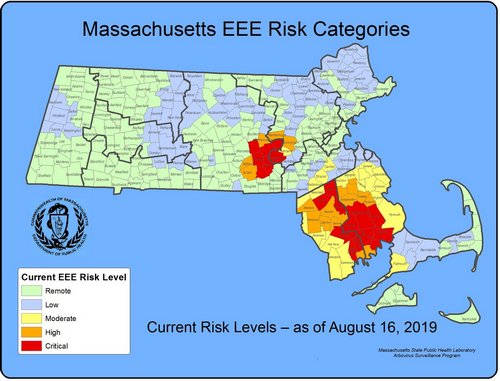Above: The most recent map of the EEE threat posed by mosquitoes in Massachussetts shows Southborough and some neighboring towns in the highest risk level category. (image from mass.gov)
The state has announced that aerial spraying is anticipated to begin for 17 communities in our area on Sunday. It isn’t certain yet when Southborough will actually be sprayed and how many times. Yesterday’s press release explains:
The Massachusetts Department of Public Health (DPH) and the Massachusetts Department of Agricultural Resources (MDAR) today announced that aerial spraying for mosquitoes will take place in parts of Worcester and Middlesex Counties which is anticipated to begin this Sunday. . .
MDAR will conduct and monitor aerial spraying in these specific areas of Worcester and Middlesex Counties anticipated to begin on Sunday, August 25, and continue over several evenings. However, the ability to spray is weather-dependent and the schedule may change. Officials will continue to monitor the area over the next two weeks to evaluate whether a second round of spraying may be required to achieve maximal effectiveness.
The spraying for this region will cover the 6 critical risk towns for mosquito-borne EEE in our area (Southborough, Grafton, Westborough, Hopkinton, Shrewsbury, Upton, and Northbridge), the five “high risk” neighbors (Northborough, Marlborough, Framingham, Millbury, and Sutton), plus Ashland (“moderate risk”), Berlin and Sudbury (“low risk”), and Worcester (“remote risk” for EEE but the only town in the area with a “moderate” or higher risk for mosquito-borne West Nile Virus).
For more details on the spraying, the public is referred to the DPH website for the latest updates. That page links to a map for spraying in our area. But that map is yet to be posted. Click here closer to Sunday to check if it has been posted.
Earlier this week, the Superintendent of Northborough-Southborough schools announced that they will be complying with the state recommendation by closing the Southborough schools’ fields from 6:00 pm to 6:00 am. With the risk in Northborough raised to “high”, I wondered if there was an impact to the Algonquin fields. Superintendent Greg Martineau informed me that they are in the process of working with Northborough Town officials to determine if any changes are necessary. They expect to have a decision within a day or two.
Here are more details from the press release:
“Due to the high risk levels in these communities, the Commonwealth is taking action to protect public health by conducting an aerial spray to reduce the area’s population of mosquitoes that transmit the EEE virus,” said MDAR Assistant Commissioner Ashley Randle. “As aerial sprays cannot completely eliminate the risk of EEE transmission, we ask the public to follow the personal protection practices suggested by DPH.”
The pesticide used is called Anvil 10+10, a product extensively tested and used in both ground-level and aerial spraying in the U.S. to control mosquitoes. Anvil 10+10 contains two ingredients: Sumithrin and Piperonyl butoxid. Sumithrin is an ingredient similar to the natural components of the chrysanthemum flower which is also found in other pesticide products used indoors, in pet shampoos, and tick control treatments. Sumithrin is rapidly inactivated and decomposes with exposure to light and air, with a half-life of less than one day in the air and on plants. In soil, it degrades rapidly. Sumithrin has proven to be extremely effective in killing mosquitoes worldwide for over 20 years. Piperonyl butoxide serves to increase the ability of Sumithrin to kill mosquitoes.
There are no health risks expected during or after spraying and there is no evidence that aerial spraying will exacerbate certain health conditions such as asthma or chemical sensitivity. No special precautions are recommended; however, residents can reduce exposure by staying indoors during spraying. Aerial spraying is not expected to have any impacts on surface water or drinking water.
Aerial spraying will be conducted in the nighttime hours when fish are less likely to be at the surface feeding and honeybees are most likely to be in their hives. However, owners should cover small ornamental fishponds during the night(s) of spraying. While it is not necessary to bring animals indoors during spraying, keeping pets inside will minimize the risk of exposure.
Although the aerial spray is considered necessary to reduce human risk, it will not eliminate it. Residents must continue to protect themselves from mosquito bites by staying indoors during peak mosquito hours, applying insect repellent when outdoors, draining standing water where mosquitoes breed, and repairing screens in doors and windows. Residents should also take steps to protect their domestic animals from mosquito bites.
For questions about aerial spraying, contact the MDAR Crop and Pest Services at (617) 626-1700.
For the most updated information on EEE risk and aerial spraying, contact the DPH Division of Epidemiology at (617) 983-6800 or visit the DPH website at www.mass.gov/guides/aerial-mosquito-control-summer-2019. For updated risk levels, mosquito results, maps and incidence of positive mosquito samples, visit www.mass.gov/dph/mosquito.
Updated (8/22/19 3:08 pm): I added the section on the school update after following up with Superintendent Martineau.



After some digging through links, I finally found the possible hours for spraying listed as early evening to 4:30 am.